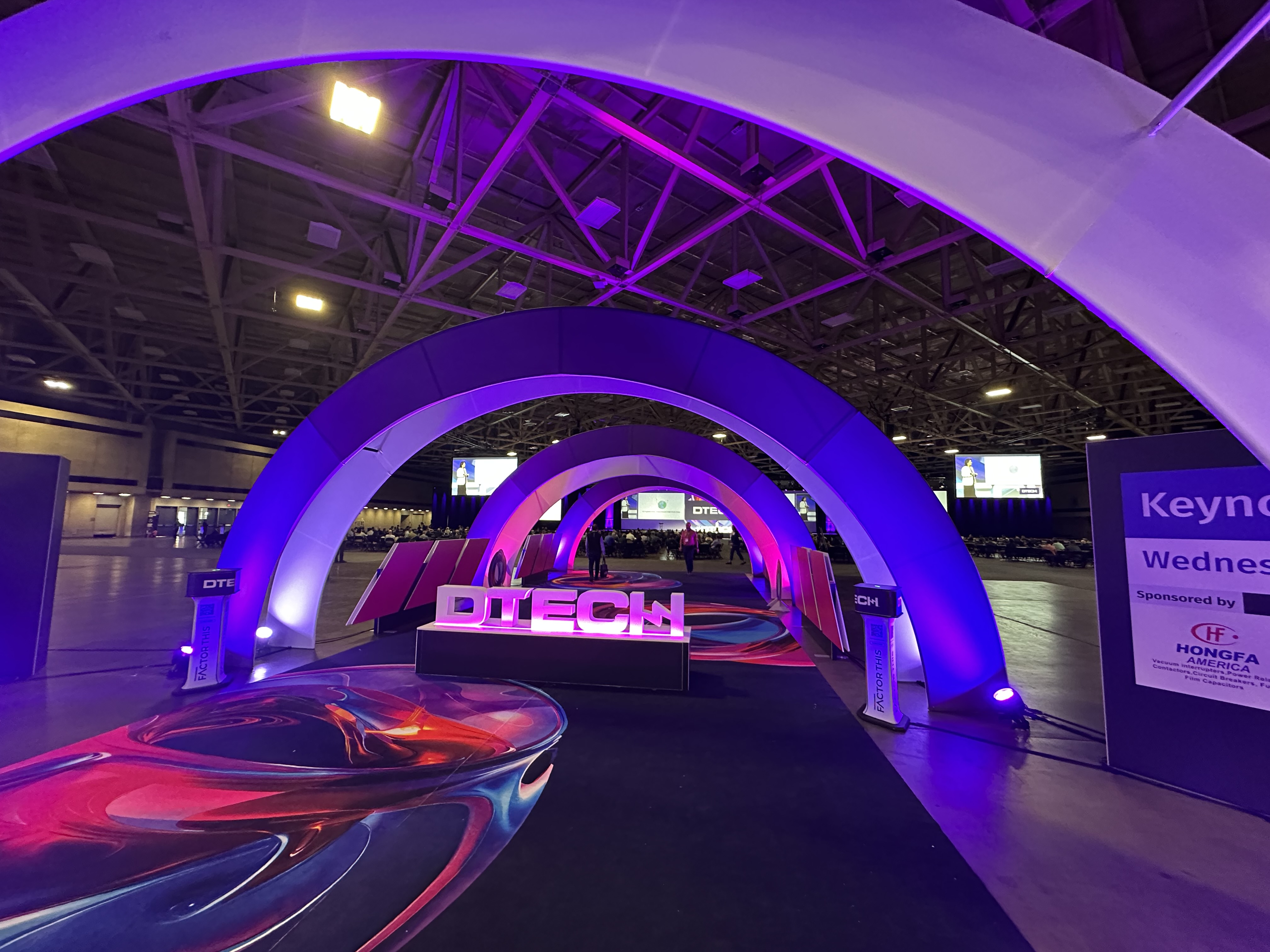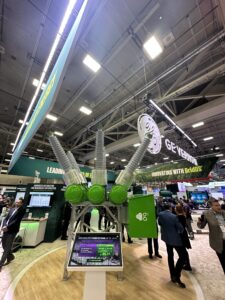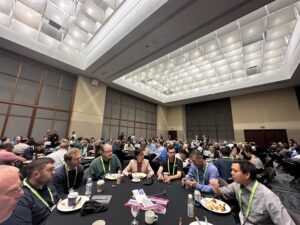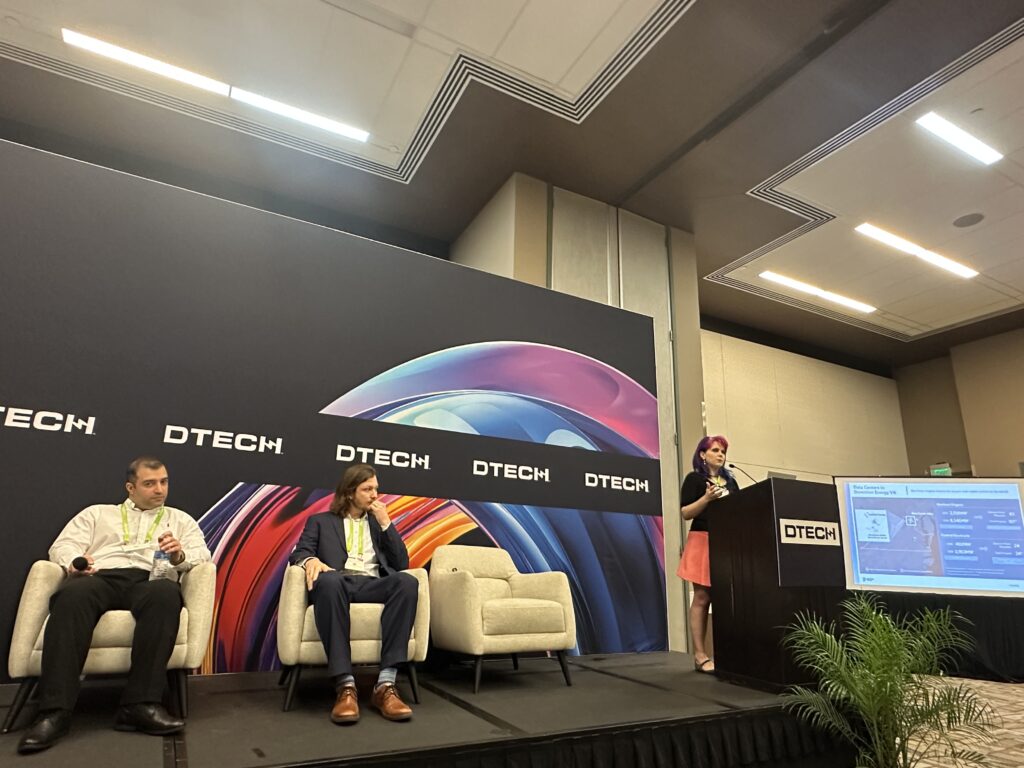
This year’s Distributech buzzed with urgency and optimism. It wasn’t just about showcasing new tech; it was about reckoning with the scale of transformation ahead. As someone who served on the planning committee, chaired sessions, and led affinity meetups for Municipals, Co-ops, and Government, I left feeling more hopeful—and more focused—than ever on where we’re headed.
Here are a few standout themes and insights that left an impression.
Big Tech Meets Big Wires
 Some of the biggest names in energy tech—Siemens, GE Vernova, and Landis+Gyr—aren’t just updating tools, they’re rethinking how the grid operates.
Some of the biggest names in energy tech—Siemens, GE Vernova, and Landis+Gyr—aren’t just updating tools, they’re rethinking how the grid operates.
-
Siemens’ advances in digital twin technology are enabling real-time grid modeling and simulation.
-
GE is pushing boundaries with virtualized protection schemes and AI-powered reliability forecasting.
-
Landis+Gyr showcased 1 MHz-resolution grid sensing that reframes distributed energy resources (DERs) not as edge cases, but as core assets in system design.
Together, these innovations mark a shift from reactive grid management to predictive, integrated, and highly scalable operations.
Prize-Winning Progress with Dominion Energy
One of the most exciting moments for our team at DISTRIBUTECH was co-presenting with Dominion Energy on the future of hosting capacity analysis for transmission.
Led by Katelynn Vance and Amirreza Sahami of Dominion, alongside our own Nick Agliano, we shared how a unique collaboration transformed a slow, manual analysis process into a fast, map-driven tool that’s already helping Dominion and other stakeholders plan for massive load growth.
What We Showed
The presentation focused on a new, GIS-integrated Hosting Capacity Map built to help planners and economic developers quickly identify where the transmission grid has available capacity to support new loads—like data centers, EV fleets, or large industrial projects.

Using automated AC-based contingency analysis—including N-1, N-1-1, and N-1-1 SCRD events—the platform calculates available line and bus capacity across Dominion’s 6,800-mile transmission system. The result: planners can now explore load addition scenarios in minutes rather than weeks.
Why It Matters
Dominion’s Virginia service area includes the largest data center market in the world, and demand is surging. In just a few years, some counties have seen quadrupling of substations and hundreds of new megawatts in delivery point requests. Managing this kind of exponential growth requires more than traditional planning tools.
By combining engineering rigor, automation, and a user-friendly map interface, this platform helps:
-
Accelerate interconnection request analysis
-
Support economic development planning
-
Identify bottlenecks early and prioritize infrastructure investment
-
Eventually assist in generation siting and policy collaboration
This work was recently recognized by the HeroX Digitizing Utilities Prize, and it was a privilege to help share the story at DISTRIBUTECH alongside the Dominion team.
Want a copy of the slides? You can grab them here.
Addressing the Transformer Bottleneck
One of the most pressing issues in grid expansion? Transformer supply constraints.
That’s why Hitachi Energy’s announcement of a $250 million investment to boost transformer production—especially in the Southern U.S.—was a headline moment. With facilities ramping up in Virginia and beyond, the hope is to relieve a key bottleneck that’s slowed everything from DER deployment to load growth accommodation.
Other manufacturers are following suit. It’s a welcome signal that supply chain constraints are finally getting the investment attention they’ve long needed.
DOE Pushes Storage to the Edge
The U.S. Department of Energy launched the Beyond the Meter: Energy Storage Integration Prize, offering up to $100,000 for technologies that help integrate behind-the-meter storage with the broader grid.
With so much of the conversation focused on front-of-meter infrastructure, this was a powerful step toward supporting consumer-sited assets and the DER ecosystem at large.
New Entrants, New Builders
The launch of Ryker Holdings at DISTRIBUTECH 2025 was a timely development in the energy sector. As a new player focusing on utility-scale construction for next-generation grid infrastructure, Ryker’s entry is particularly significant given the current constraints faced by Engineering, Procurement, and Construction (EPC) firms.
Recent discussions at industry forums have highlighted that EPC firms are operating at or near full capacity, limiting their ability to take on new projects. This bottleneck poses challenges for the timely deployment of renewable energy projects and grid modernization efforts. The emergence of companies like Ryker introduces much-needed capacity and innovation into the EPC landscape, helping to alleviate these constraints and accelerate infrastructure development.
Rulebooks Catching Up to Reality
 Regulatory discussions this year finally felt aligned with on-the-ground innovation.
Regulatory discussions this year finally felt aligned with on-the-ground innovation.
Key topics included:
-
FERC Order 2222: enabling aggregated DERs to participate in wholesale markets.
-
The rise of Distribution System Operators (DSOs).
-
The growing need to assess bulk power system impacts of distributed assets.
Slowly but surely, policy is catching up to the complexity and speed of technical progress.
A Spotlight on Transmission
One of the most powerful additions to DISTRIBUTECH 2025 was the inaugural Transmission Summit, and it’s hard to overstate what a critical—and overdue—conversation it was. Thanks to the leadership of Julia Selker (WATT Coalition, Grid Strategies), the summit brought together utility planners, economists, developers, and technologists to tackle the core question: how do we build the transmission system the energy transition demands?
Panelists like Zheng Zhao (MISO), Michael Hagerty (Brattle Group), and Patrick Brown (NREL) emphasized the shift toward 10–20 year scenario-based transmission planning that quantifies not just reliability, but economic, policy, and capacity benefits. Discussions ranged from the value of long-distance, high-capacity lines to the need for regional coordination and advanced technologies like DLR, smart valves, and high-performance conductors. Perhaps most compelling: the summit made it clear that grid-enhancing technologies (GETs) are no longer fringe—they’re essential. And while planning frameworks still lag behind, efforts like FERC Order 1920, the Joint Targeted Interconnection Queue (JTIQ), and groups like EPRI and ESIG are helping pull them into the mainstream. Hats off to Julia for creating the platform this topic deserves.
One of the most impactful comments came near the end when Dr. Adria Brooks talked about the balance between needing “more grid” with keeping costs low for ratepayers. Brooks summed by driving the point that “we need the right more grid.”
It was a timely reminder that it’s not just about building more—it’s about building smarter, and aligning expansion with the outcomes that matter most.
Startups in the Spotlight: The Initiate Hub
At DISTRIBUTECH 2025, the Initiate Hub was one of the most dynamic corners of the conference—buzzing with the energy of founders, engineers, and innovators shaping the next generation of grid technology.
Fifty-eight startups from across the globe took the stage to pitch ideas spanning DER management, grid intelligence, clean tech, and more. What made this year’s cohort stand out wasn’t just creativity—it was execution. Many of the teams came to the table with working pilots, live deployments, or hard-won traction with utilities.
The weeklong pitch competition wrapped up with four standout companies recognized for their innovation and potential:
-
🥇 1st Place: ThinkLabs – Specializing in AI-driven predictive analytics for grid performance, ThinkLabs impressed judges with a platform built for real-time decision-making and system resilience.
-
🥈 2nd Place: Treeswift – Using aerial robotics and advanced sensing, Treeswift is transforming how utilities and forestry managers monitor vegetation around power infrastructure.
-
🥉 3rd Place: Senpilot – Focused on lightweight, scalable pole-mounted sensors, Senpilot offers a new approach to real-time distribution grid visibility.
-
🏅 Duke Energy Award: DG Matrix – Recognized by Duke Energy for their work in distributed generation coordination and grid-edge intelligence.
And a final shoutout to our Richmond-based friend of Simple Thread, Todd Emerson from PluralFusion who participated in the hub and did a great job sharing how his tech can assist with employee safety for utilities.
The pitch stage made it clear: innovation in the power sector isn’t just coming from the top down—it’s growing from the ground up. These companies are proving that startups can not only bring new ideas but deliver real solutions that scale with utility needs.
Our Team on the Ground
DISTRIBUTECH was a proud moment for our crew at Simple Thread:
-
Justin Etheridge, CEO, connecting with partners and peers from across the industry
-
Nick Agliano, presenting award-winning work on hosting capacity
-
Inalvis Alvarez, our newest distributed power systems engineer, diving into the conference and bringing fresh insights back to the team
Looking Ahead
As utilities, regulators, and innovators double down on grid modernization, we’re proud to be in the mix—designing software and engineering solutions that help utilities plan, adapt, and deliver in a distributed energy world.
Want to learn more about our work in hosting capacity, interconnection, or grid modeling?
Let’s talk. Or check out our latest projects to see how we’re helping shape the future of power systems.

Loved the article? Hated it? Didn’t even read it?
We’d love to hear from you.




